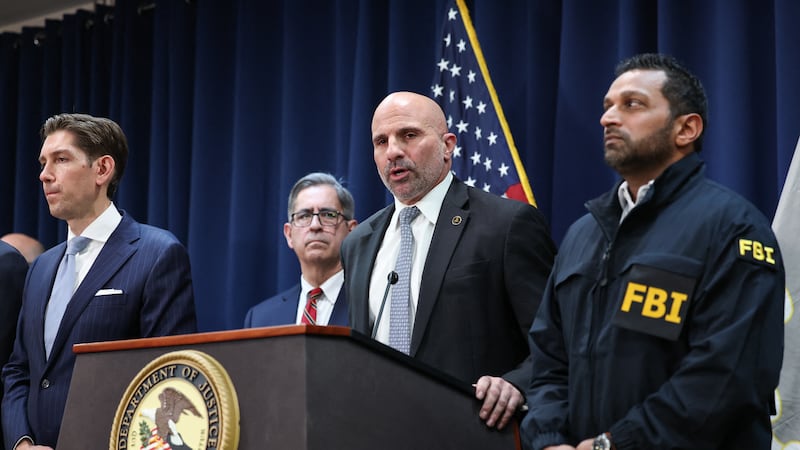In a dramatic photograph from September 1921, a prisoner lies sprawled against a wall in Kilmainham Gaol. His eyes are closed, his mouth open. Four hard-bitten British soldiers crouch around the body, one with a cigarette dangling from his lips.
The caption reads: “Shot while trying to escape.” But this is not a forgotten atrocity of the War of Independence. The “dead” man is alive and, like the “soldiers”, acting. All four are inmates of Kilmainham and the prostrate figure has been shot only in the photographic sense, by a camera they have smuggled in.
Such theatrical scenes, with props including military uniforms and fake guns, are among the sub-themes of a new exhibition – The Prisoners’ Lens: Secret Photography in Kilmainham Gaol, 1921 – now running at the prison museum.
And they remind us that although the events of 1916 and afterwards are usually said to have been inspired by poets, they were at least as much the work of playwrights and actors.
READ MORE
The Easter Rising was staged in more ways than one. The Plunkett family owned a theatre. Many other protagonists of 1916 wrote or performed plays, even James Connolly. It was no accident that pictures of the GPO, before and after the rebellion, resemble a theatre set.
As Roy Foster wrote in Vivid Faces: The Revolutionary Generation in Ireland 1890 to 1923: “ ... when the insurrection broke out, several people mistook the manoeuvres for street theatre; Constance Markievicz was asked by passersby at Liberty Hall if she was rehearsing a play for children, and Joseph Holloway, encountering a copy of the ‘Proclamation of the Irish Republic’, took it at first for a playbill.”
Speaking of confusions, another of the pictures in the Kilmainham exhibition features two prisoners – Tommy O’Reilly and Eddie Horn – dressed as soldiers, with the caption: “The Tunnel King and his Tout.” This has puzzled even the show’s curators, who are unsure whether the nicknames refer to “characters they were playing in a skit”, or to an actual tunnel they were digging at the time.
But most of the photographs are simple portraits, of individuals and groups. Some depict inmates boxing or giving and receiving haircuts. More often the subjects just stare at the camera, the only arms on display being the ones that – in the typical pose – they have folded resolutely across their chests.
Several pictures also feature dogs, of which there were at least three in the prison, all of the terrier variety. They included one known as “the Fanners’ dog”, after a group of prisoners arrested in June 1921 while attending an IRA signalling class. But these were not dogs of war, probably: they may have been in jail for their ratting skills and condoned by the authorities to keep the rodent population down.
[ Roots and Branch: Alex Haley’s lesser known Irish heritageOpens in new window ]
Secret as the camera was, it depicts the prison as a relatively relaxed place in the later months of 1921. Which indeed it became after the ceasefire of July and the agreement on peace talks.
This may also explain why the prisoners were confident enough to leak some of the pictures to the press, including one of a Mass being held in the main hall, published by the Irish Independent in September 1921. If the governor hadn’t known about the camera before that, he did then.
By December, anyway, the prisoners were being released. The exhibition features a Pathé newsreel showing them emerge from the front door to cheering crowds. The men are greeted by Christy Byrne, their former commanding officer, who had featured in some of the pictures but must have been freed earlier. Even a British officer at the door enters the mood, exchanging a warm handshake with one departing inmate, clearly a friend.
Elsewhere, meanwhile, the same treaty that had liberated the prisoners was causing tensions to rise again. The Pathé reel follows a carriage full of the newly freed arriving at the Mansion House, where the Dáil was sitting and where Lord Mayor Laurence O’Neill came out to shake hands with the passengers.
Newspapers noted that the ex-prisoners made no attempt to interrupt the “serious deliberations within” (although the Treaty debates proper did not begin until a week later, in nearby Earlsfort Terrace).
[ A Feast of Festy: A new lease of life for a colourful Irish nameOpens in new window ]
In the meantime, the dramatic footage took its place alongside drama of the Hollywood kind. In Dublin’s Lyceum Picture Theatre, the Pathé newsreel was part of a support bill for a Charlie Chaplin movie.
The photography exhibition, compiled from material donated by friends and relatives, is in keeping with the latter-day history of Kilmainham Gaol, in which former inmates took control of their own story and its dramatisation.
This included saving the abandoned prison from demolition and restoring it as a museum. Now it’s one of Ireland’s most popular tourist attractions and in the process has helped vindicate an old joke. As the exhibition notes, inmates used to enjoy referring to the gaol as the “Kilmainham hotel”. Today its tens of thousands of visitors include the residents of a newer building just opposite: the Kilmainham Hilton.













